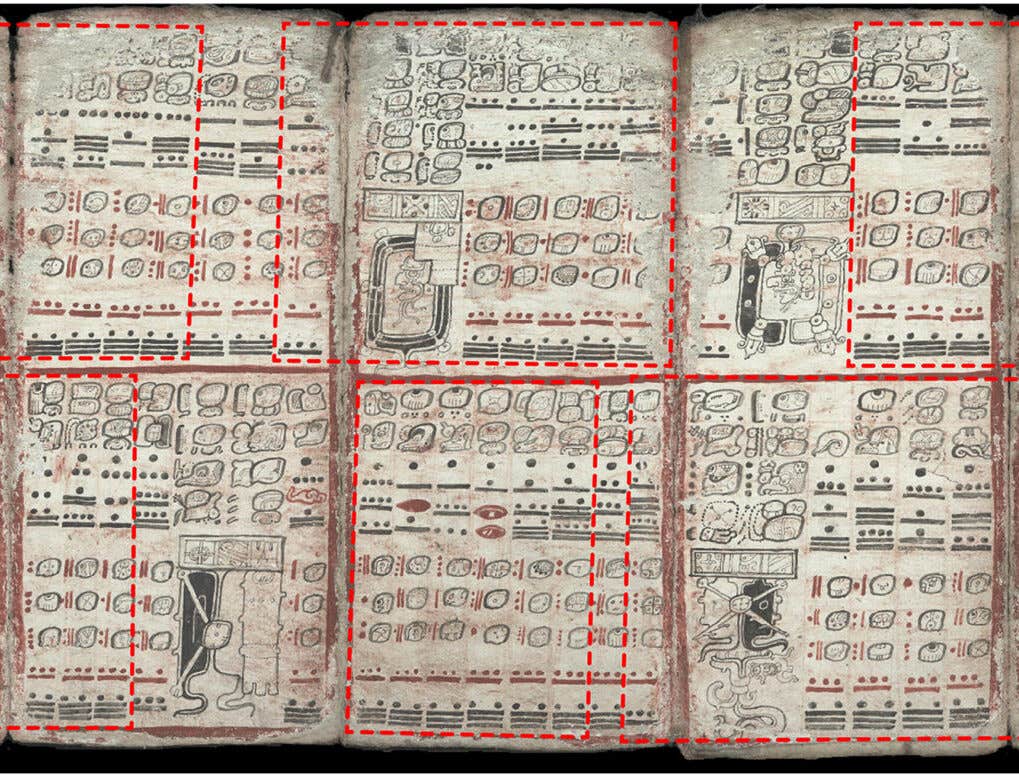Mayan astronomers built a 700-year-long eclipse calendar centuries before telescopes
New research reveals how the Maya used math and observation to predict solar eclipses centuries in advance.

 Edited By: Joseph Shavit
Edited By: Joseph Shavit

A new study of the Dresden Codex uncovers how Maya astronomers predicted solar eclipses for centuries using simple math and careful skywatching. (CREDIT: Science Advances)
More than a thousand years ago, astronomers from the Maya civilization developed one of the most sophisticated time-keeping systems in the ancient world—a system that could predict solar eclipses for centuries without using telescopes or computers.
The new research published in the journal Science Advances describes how the famous eclipse table in the Dresden Codex worked and how it predicted eclipses for centuries by a combination of math, observation, and pattern matching.
Redoing the Rules of Ancient Astronomy
Historians used to believe that the Maya eclipse table—405-lunar-month cycle written on the Dresden Codex—simply wrapped around whenever it reached its climax. The new research indicates that's not the case. Restarting on the final date, the study states, would have made predictions go awry and lose accuracy.
Instead of overwriting previous tables at each turn, Maya daykeepers reinitialized new tables at specific points in the cycle, usually after 358 lunar months and sometimes after 223. This careful recalibration kept their predictions aligned with real-world eclipse cycles across multiple generations. By doing so, Maya astronomers effectively devised a self-correcting forecasting system—an achievement that remains unmatched in the premodern era.
The Math Behind the Magic
At the center of the Dresden Codex table is a simple but lovely mathematical relationship: 405 lunar months = 11,960 days. That's almost an exact match, missing the true lunar average by only 0.11 days. The precision of this relationship suggests the table originally was a crude lunar calendar that was subsequently altered to mark solar eclipses.
The researchers, John Justeson from the University at Albany and Justin Lowry from SUNY, found that the number of 405 months is exactly in tune with the Maya's holy 260-day calendar. There are months in the table almost perfectly coinciding with multiples of the ritual number—44 and 88 months just one day short of 5 and 10 cycles of 260 days, and month 405 on exactly the 46th cycle. This coincidence of cycles would have been easy for priests and astronomers to foresee lunar phases, and later eclipses.
The 405-month eclipse table had evolved from a lunar calendar under which the 260-day divinatory calendar brought the lunar cycle into commensurability, "the authors stated. That is, the lunar calendar of the Maya formed the basis for their eclipse predictions.
Changing Lunar Data To Predict Eclipses
The Dresden Codex has 69 "stations" for new moons that cover 405 months. Of these, 55 suggest potential eclipse dates, and 14 are placeholders to maintain the rhythm of the table. Most of these stations are separated by six lunar months, or about the average that there is between eclipse seasons.
Occasionally, the sequence jumps 11 or 17 months—small but important variations that keep the predictions close to the Moon's orbital change. By incorporating these tiny modifications, the Maya were able to stay fantastically near to the precise positions of the lunar nodes at which eclipses occur.
The researchers modeled eclipse visibility across the Maya world over 350 to 1150 CE. They found that using a visibility window of about ±12 days from a node accounted for 145 solar eclipses visible to the ancients. Comparing interval events among these, they identified repeating patterns—specifically a recurring 669-month period, or three Saros cycles, where eclipses occur nearly the same local time of day and longitude.
Why Calendars Needed to be Reset
Unless reset from time to time, eclipse forecasts would gradually become disconnected. The group showed that starting new tables on inner points—358 or 223 months in the series—halted the drift. With a four-to-one ratio of 358-month to 223-month resets, a master cycle of 1,655 lunar months, or some 48,873 days, kept the forecasts tightly in line with fact.
This rhythm not only sustained the table's accuracy but also blended quite naturally with Maya numerology. The 358th month was the midpoint of a seven-station cycle, and the 223rd month offered an offset correction when the system began to degrade.
The brilliance of this design is that it would never, ever need to be redone. By following this small rule—don't start anew at the end, but circle around at measured points—the Maya could forecast each solar eclipse visible in their area for centuries.
When the Table Was in Use
By matching dates noted in the Dresden Codex to recognized historical eclipse observations, the article limits the likely use of the Dresden Codex table to late Classic and early Postclassic times, 1083-1148 CE, likely in northern Yucatán. In each instance, the table begins and ends with real eclipses visible in the area of the Maya—a lovely confirmation that the system was observationally founded and mathematically sound.
But such sophistication didn't occur by accident. The earliest extant Maya lunar observations are 361 CE. A century later, daykeepers would have had sufficient cycles to calibrate a lunar table like Dresden's. By 550 CE, the foundation of this predictive system was likely set in place.
Centuries Ahead of Their Time
The findings represent the Maya not as mystics stumbling in the dark with guesses regarding the sky but as cautious scientists refining their craft through observation over centuries. Their ability to chart lunar cycles in anticipation of eclipses demonstrates a deep sense of motion and time, accomplished without telescopes, metal instruments, or written formulas.
Each one of the Dresden Codex entries is more than a date—it's evidence of the mathematical cleverness of a civilization and its determination to keep celestial events in harmony with sacred calendars.
Practical Implications of the Research
This new analysis reconfigures historians' and astronomers' understanding of Maya science. It demonstrates that pre-modern civilizations were capable of developing predictive systems comparable to early modern astronomy through persistence, discernment of patterns, and inventive mathematics. Insight into how the Maya accomplished such accuracy provides new insights into how scientific thought can arise independently of modern technology.
To contemporary scholars, these revelations could help refine models of ancient stargazing practices, early calendar making, and even human origins of formalizing long-term predictive science.
To the rest of us, it serves as a reminder that curiosity, patience, and math were enough to calibrate the night sky as a centuries-long calendar.
Research findings are available online in the journal Science Advances.
Related Stories
- Royal tomb discovery changes what’s known about Maya history
- Student accidentally finds ancient Mayan city hidden in Mexican jungle
- Major discovery explains why the ancient Mayan civilization collapsed
Like these kind of feel good stories? Get The Brighter Side of News' newsletter.
Shy Cohen
Science & Technology Writer
Joseph Shavit
Science News Writer, Editor-At-Large and Publisher
Joseph Shavit, based in Los Angeles, is a seasoned science journalist, editor and co-founder of The Brighter Side of News, where he transforms complex discoveries into clear, engaging stories for general readers. With experience at major media groups like Times Mirror and Tribune, he writes with both authority and curiosity. His work spans astronomy, physics, quantum mechanics, climate change, artificial intelligence, health, and medicine. Known for linking breakthroughs to real-world markets, he highlights how research transitions into products and industries that shape daily life.



